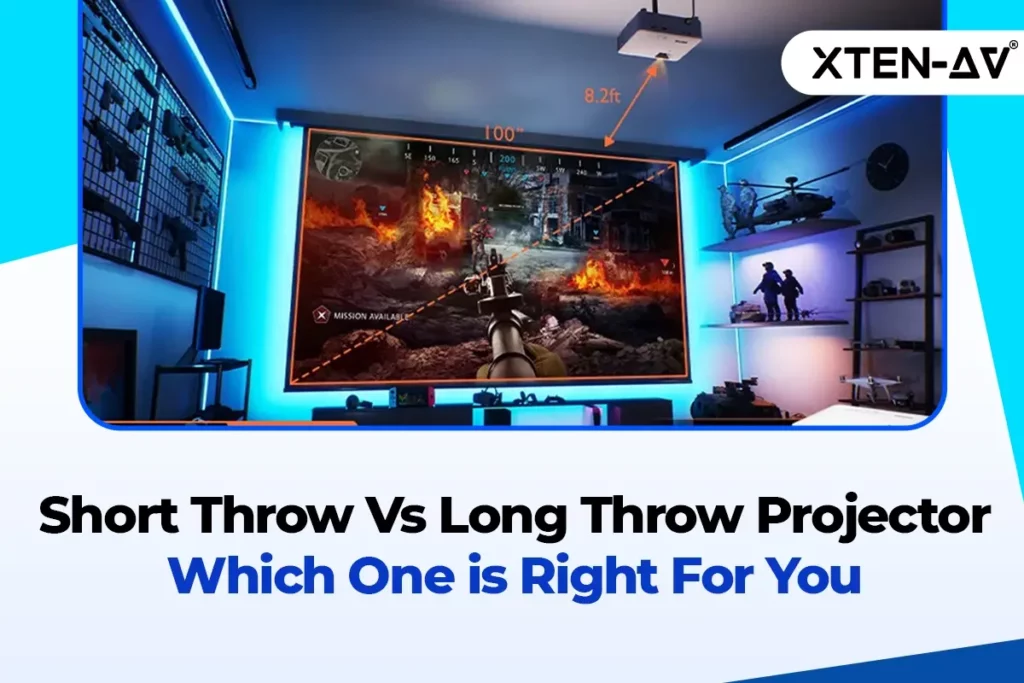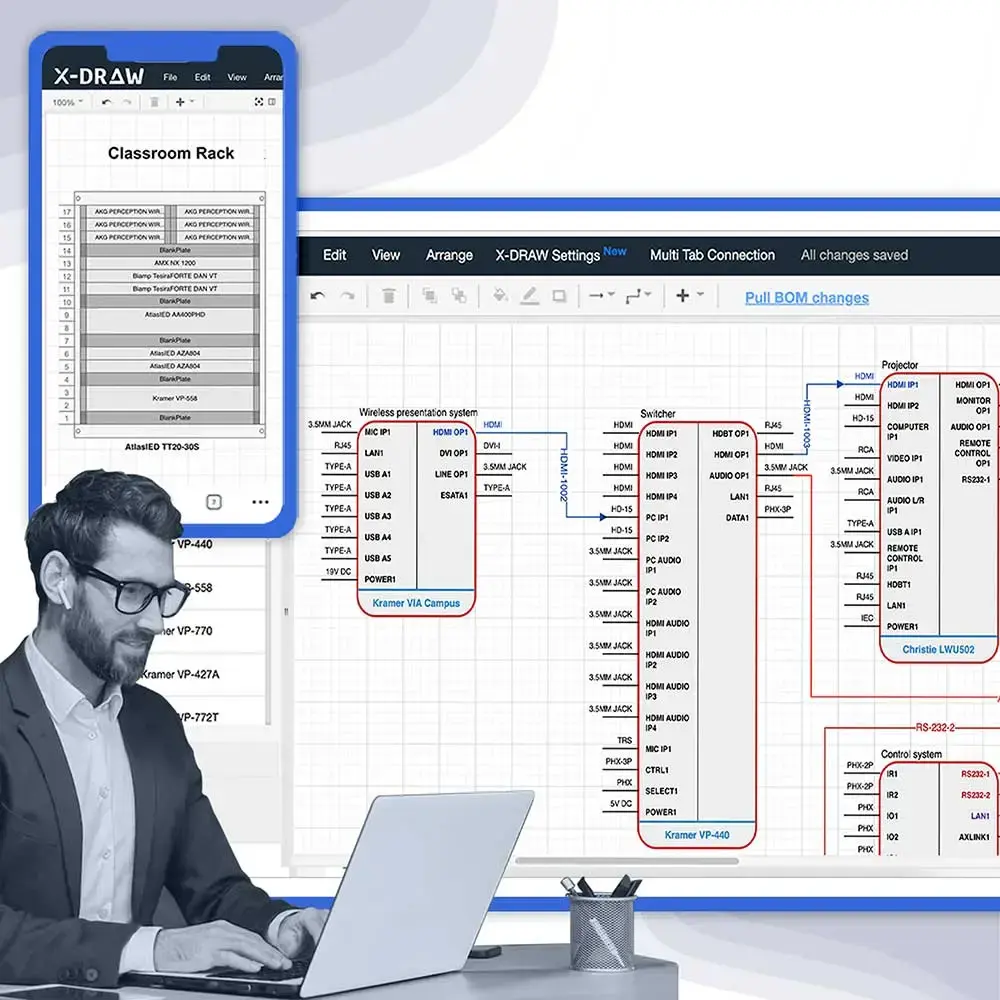Short Throw Vs Long Throw Projector: The Ultimate Guide to Choosing the Right Projector
Setting up a conference room or home theater with the perfect projector involves making key decisions, one of the most critical being the throw distance. But don’t worry—we’ve got you covered. In today’s blog, we’re diving into the short throw vs long throw projector debate, exploring their pros and cons, and offering tips on choosing the best one for your needs. By the end of this post, you’ll have all the knowledge you need to create a high-quality, functional projection setup.
Find, Plan, and Integrate the Perfect Projector in Minutes with XTEN-AV
Key Takeaways
- Understand what throw distance means and why it’s important.
- Discover the advantages and disadvantages of short throw and long throw projectors.
- Learn how to choose the best projector based on your room size, setup, and budget.
The all-in-one solution for your AV needs
Transform your audio-visual experience with XTEN-AV.
No Credit Card required
What Does Throw Mean?
Throw distance refers to the distance between the projector and the screen. This distance determines how large the image will be when projected. Projectors are typically categorized as short throw, long throw, or ultra-short-throw projectors based on this distance. Choosing the right throw distance is crucial for achieving the best image quality and maximizing the use of your space.
What Is A Short Throw?
A short throw projector can produce a large image from a short throw distance. Typically, these projectors are placed between 3 to 8 feet from the screen. They are ideal for smaller rooms or setups where the projector cannot be placed far from the screen.
Pros
- Space Efficiency: Perfect for small rooms or spaces where the projector needs to be close to the screen.
- Reduced Shadows: Minimized shadows and obstructions, especially useful in presentations where the speaker moves around.
- Ease of Setup: Generally easier to set up since they don’t require as much space.
Cons
- Cost: Short throw projectors can be more expensive than long throw counterparts.
- Heat and Noise: Due to their close proximity to the screen and audience, heat and fan noise can be more noticeable.
- Limited Placement Flexibility: Less flexibility in placement options as they need to be positioned closer to the screen.
What Is A Long Throw?
A long throw projector is designed to project images from a greater distance, usually more than 10 feet from the screen. These projectors are ideal for large rooms, auditoriums, and home theaters where space is not constrained.
Pros
- Flexibility in Placement: This can be placed further away, providing more flexibility in room setup.
- Lower Cost: Generally, they are more affordable than short throw projectors.
- Larger Screen Sizes: Capable of projecting larger images, making them suitable for big venues.
Cons
- Space Requirements: Requires more space, which can be a limitation in smaller rooms.
- Installation Complexity: Often requires more planning and setup, including mounting and cable management.
- Potential for Shadows: More prone to shadows and obstructions if someone walks between the projector and the screen.
What’s The Difference Between Short Throw And Long Throw Projectors?
The primary difference between short throw vs long throw projectors lies in their throw distance and the resulting image size. Here’s a quick comparison:
Feature | Short Throw Projector | Long Throw Projector |
Throw Distance | 3 to 8 feet | 10 feet and beyond |
Ideal for | Small rooms, classrooms, close-up setups | Large rooms, auditoriums, home theaters |
Image Size | Medium to large | Large to very large |
Installation | Easier, less space needed | Requires more planning, more space needed |
Cost | Generally more expensive | Generally more affordable |
Shadowing | Minimal | Potential for shadows |
Noise and Heat | More noticeable | Less noticeable |
XTEN-AV's Projector Throw Distance Calculator
Choosing the right throw distance can be challenging, but XTEN-AV makes it easier with our Projector Throw Distance Calculator. This free tool helps determine the ideal throw distance for your projector and room setup. By inputting your room dimensions and desired screen size, you can quickly see whether a short throw or long throw projector is the best fit for your space.
How to Use the Projector Throw Distance Calculator
- Visit the Calculator: Go to the XTEN-AV Projector Throw Distance Calculator.
- Enter Room Dimensions: Input your room’s width, length, and height.
- Select Screen Size: Choose your desired screen size and aspect ratio.
- View Recommendations: The calculator will provide optimal throw distance and projector placement options.
This tool can save you time and ensure you select the right projector for your needs, avoiding potential pitfalls and maximizing your viewing experience.
Short-Throw vs. Long-Throw Projector: Which Is Better For You?
You must consider the following factors to determine the best fit between short-throw and long-throw projectors for a home theater system during AV installation:
- Room Size and Throw Distance: Measure your room to determine how much space you have for the projector. A short-throw projector is best for small to medium-sized rooms, projecting clear images from a shorter distance.
On the other hand, a long-throw projector suits larger spaces as it requires a greater distance from the projector screen to cast a high-quality image. - Budget: Short-throw projectors can be more expensive. Therefore, you must factor in your budget and ensure the setup cost does not outweigh its benefits.
- Usage and Interactive Features: Think about the projector’s usage and interactive features and how they affect user interaction.
If you have to use the projector for presentations in business meetings or classrooms where you’ll be moving around, a short-throw projector can help reduce shadows.
However, A long-throw projector might provide a better cinematic experience for home theaters as it requires a more significant distance between the user and the screen, minimizing user interaction. - Flexibility: Determine the availability of options in terms of projector placement. Long-throw projectors offer more placement options, which can be a deciding factor in larger rooms.
- Image Quality: While both projectors can offer excellent image quality, you must choose the projector with the resolution and brightness compatible with your viewing environment.
- Screen Size: The long-throw projector will be the best choice if you need a projector that can project an image up to 100 inches wide. However, the short-throw projector will be your best bet if you require one that can cast a projected image of 100 cm or 120 cm from a short distance.
Tips For Choosing What’s Best Projector Screen Size
When deciding between a short throw vs long throw projector, consider the following factors:
- Room Size and Layout: Measure your room to determine how much space you have for the projector. A short throw projector is best for small to medium-sized rooms, while a long throw projector suits larger spaces.
- Budget: Short throw projectors can be more expensive, so consider your budget and whether the benefits justify the cost for your setup.
- Usage: Think about how you will use the projector. If it’s for presentations where you’ll be moving around, a short throw projector can help reduce shadows. For home theaters, a long throw projector might provide a better cinematic experience.
- Flexibility: Consider the flexibility you need in terms of projector placement. Long throw projectors offer more placement options, which can be a deciding factor in larger rooms.
- Image Quality: Both projectors can offer excellent image quality, but ensure that the one you choose supports the resolution and brightness you need for your environment.
Are you still unsure what to choose? Don’t worry—check out our detailed guide on choosing the best projector screen size.
AV Design Mastery + Winning Proposals = 10x Productivity!
- Automatic Cable Labeling & Styling
- 100+ Free Proposal Templates
- Upload & Create Floor Plans
- 1.5M Products from 5200 Brands
- AI-powered ‘Search Sense'
- Legally Binding Digital Signatures
Conclusion
Navigating the challenges of choosing the right projector can seem overwhelming, but understanding the differences between short throw and long throw projectors will help you make an informed decision. Whether you need a space-saving solution or a projector that delivers a large image from afar, knowing the pros and cons of each type will guide you to the perfect choice. Investing in the right projector will enhance your conference room or home theater’s functionality and create an impressive viewing experience.
Ready to take your conference room to the next level? Book a demo with us today and see how easy it is to design a workspace with X-DRAW that meets all your needs!
Frequently Asked Questions
Short throw projectors can project a large image from a short distance (3 to 8 feet), making them ideal for small rooms or close-up setups. Long throw projectors, on the other hand, require a longer distance (10 feet or more) and are suitable for large rooms or auditoriums.
Generally, short throw projectors can be more expensive than long throw projectors due to their specialized lenses and design. However, the price can vary based on features and brand.
While using a long throw projector in a small room is possible, it might not be practical due to space constraints and potential shadowing issues. Short throw projectors are better suited for small spaces.
A short throw ratio projector has a throw ratio of less than 1:1, meaning it can project a large image from a short distance. For example, a throw ratio of 0.5:1 means the projector can produce a 10-foot-wide image from just 5 feet away.
While not always necessary, using a screen designed for short throw projectors can enhance image quality by minimizing reflections and ensuring better focus.
You can use tools like the Projector Throw Distance Calculator to determine the ideal throw distance for your projector based on your room size and desired image size.
Ultra-short-throw projectors are a great alternative for even smaller spaces or where the projector must be placed close to the screen. They offer similar benefits to short throw projectors but with even shorter throw distances.
For long throw projectors, look for models that offer high brightness and resolution suitable for large spaces. Brands like Epson, Sony, and BenQ have a range of long throw projectors that cater to different needs and budgets.
Short throw laser projectors can offer superior performance with higher brightness, better color accuracy, and longer lifespan than traditional lamp-based projectors. They are an excellent choice for those looking for high-quality projections in small spaces.
Long-throw and short-throw projectors are both suitable for home theaters. However, you must make a choice depending on your room size. A long-throw projector might be perfect if your theater space is ample. A short-throw projector is better if you have limited space or want a more adaptable setup.
Typically, Image quality is independent of the throw distance. Long-throw and short-throw projectors can produce high-quality images, depending on the model and its features, including brightness, contrast ratio, and resolution.


